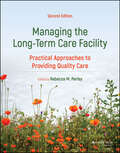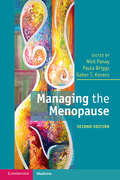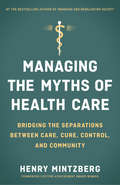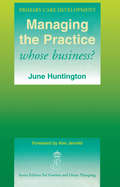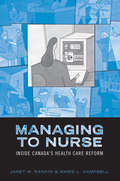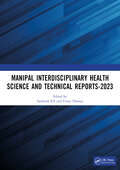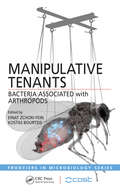- Table View
- List View
Managing the Diabetic Foot
by Michael E. Edmonds Alethea V. FosterFoot problems in diabetic patients are some of the most challenging complications to treat, due to an often quite late presentation of symptoms from the patient. Therefore visual recognition of presenting clinical signs is absolutely key for a successful diagnosis and subsequently, the right management programme. The 3rd edition of Managing the Diabetic Foot once again provides a practical, handy and accessible pocket guide to the clinical management of patients with severe feet problems associated with diabetes, such as ulcers, infections and necrosis. By focusing on the need for a speedy response to the clinical signs, it will enable doctors make rapid, effective management decisions in order to help prevent deterioration and avoid the need for evental foot amputation.Each chapter focuses specifically on the different stages of foot disease and the clinical management required at that particular stage, ie, the normal foot; high-risk foot, ulcerated foot, infected foot, necrotic foot and unsalvageable foot.Full colour throughout, it will feature over 150 clinical photos, numerous hints and tips to aid rapid-reference, as well as the latest national and international guidelines on diabetic foot management.Managing the Diabetic Foot, 3E, is the ideal go-to clinical tool for all diabetes professionals, specialist diabetes nurses and podiatrists managing patients with diabetic foot problems.
Managing the Experience of Hearing Loss in Britain, 1830–1930
by Graeme Gooday Karen SayerThis book looks at how hearing loss among adults was experienced, viewed and treated in Britain before the National Health Service. We explore the changing status of ‘hard of hearing’ people during the nineteenth century as categorized among diverse and changing categories of ‘deafness’. Then we explore the advisory literature for managing hearing loss, and techniques for communicating with hearing aids, lip-reading and correspondence networks. From surveying the commercial selling and daily use of hearing aids, we see how adverse developments in eugenics prompted otologists to focus primarily on the prevention of deafness. The final chapter shows how hearing loss among First World War combatants prompted hearing specialists to take a more supportive approach, while it fell to the National Institute for the Deaf, formed in 1924, to defend hard of hearing people against unscrupulous hearing aid vendors. This book is suitable for both academic audiences and the general reading public. All royalties from sale of this book will be given to Action on Hearing Loss and the National Deaf Children’s Society.
Managing the Global Health Response to Epidemics: Social science perspectives
by Mathilde Bourrier Claudine Burton-Jeangros Nathalie BrenderRecent epidemics have prompted large-scale international interventions, aimed at mitigating the spread of disease in a globalized world. During a crisis, however, global health actions – including planning and organizing, communicating about risk, and cost–benefit evaluations – aren’t usually part of a single, integrated global response. Arguing that an uncoordinated approach can be challenged by local conditions and expectations, generating a wide range of resistance and difficulties, this volume provides important insights for future outbreak management and global health governance. Drawing on experiences with A(H1N1) and Ebola virus disease, the book is divided into three parts looking at how responses to global health crises have developed, lessons learned from particular pandemics and the ethical implications of our management of them. Individual chapters focus on, among other issues, financing, cost–benefit analysis, matrix management, risk communication and organizational strategies. Taking a social science perspective, this valuable book outlines the current state of global health emergency responses and explores ways in which they can be improved. It is a useful read for academics and practitioners interested in global health, the sociology of health and illness, health economics and emergency management.
Managing the Kidney when the Heart is Failing
by George L. BakrisThe presence of Chronic Kidney Disease (CKD) increases the risk of death from cardiovascular causes and makes the management of heart failure difficult. The coexistence of CKD and heart failure is increasing in prevalence worldwide and requires a unique and subtle approach to patient management. Managing the Kidney in Heart Failure focuses on the therapeutic management of cardio renal patients. Common heart and kidney failure conditions are presented along with treatment scenarios aimed to reduce cardiovascular mortality and preserve kidney function. Co-authored by a Nephrologist and Cardiologist, each chapter of this concise and practical handbook offers a unified perspective to these chronic conditions.
Managing the Laboratory Animal Facility
by Jerald SilvermanPraise for the Previous Editions "The author brings in management wisdom from the world outside laboratory animal medicine and veterinary medicine. As a result, there is a rich mixture of the experience of a seasoned professional and the theoretical framework used by schools of management …. I recommend this book to managers and laboratory animal specialists at any stage of their careers." —Franklin M. Loew, DVM, PhD, DACLAM, JAVMA, Vol. 222, No. 6, 2003 "… This book is a good informational resource for any new manager to the field of laboratory management. The information is presented in a way that will keep your interest and stimulate you to think how it can benefit you and the facility in which you work." —Susan K. Cutter, BS, RVT, RLATG, Purdue University, West Lafayette, Indiana, USA, LAMA Review Written in Jerry Silverman’s trademark style, Managing the Laboratory Animal Facility, Third Edition provides the reader with sound management theory and associated management practices that are easy to read, easy to understand, easy to implement, and pertinent to the daily management and leadership of laboratory animal facilities. Maintaining the practical focus of previous editions, this greatly expanded volume presents the critical knowledge needed to help you make efficient and effective use of the key resources that are used every day by vivarium managers – people, time, money, and information. New to the Third Edition Incorporating the latest developments in management theory and application, the edition contains approximately 100 pages of new and expanded material. This more detailed coverage: Discusses lean management concepts and practices and their application to laboratory animal science Adds information on many essential topics, especially in human resources management in its treatment of negotiations, influence, and performance reviews Provides a large number of revisions and updates to Appendix 2 in its presentation of Per diem calculations Includes an extensive list of references for further study of specialized topics
Managing the Long-Term Care Facility: Practical Approaches to Providing Quality Care
by Rebecca M. PerleyPractical and compassionate approaches to providing quality care and safeguarding quality of life The second edition of Managing the Long-Term Care Facility: Practical Approaches to Providing Quality Care updates the first edition’s discussion of the operational requirements necessary to manage a skilled nursing facility. This book presents sensitive and empathic regulatory compliant methods for the delivery of care that fosters an empowering environment for all stakeholders. Additional new information includes aging in place, trauma-informed care, ethical dilemmas and collaborative decision-making, workforce culture, and surveys, enforcement actions, and appeals. The pedagogical tools include chapter summaries with quiz questions and case studies. Instructors also have access to PowerPoint slides and test banks. This book is an excellent resource for students and individuals interested in working in long-term care and other health care industries. The updated best practices for clinical and non-clinical roles within the facility and material on resident advocacy and other important topics provide valuable information for the reader. Working professionals can benefit from the emphasis placed on practical approaches to facilitate person-centered and whole person care and a facility’s sustainability.
Managing the Long-Term Care Facility: Practical Approaches to Providing Quality Care
by Rebecca PerleyPractical approaches to the operation of long-term care facilities Managing the Long-Term Care Facility provides a comprehensive introduction to the growing field of long-term care. Taking a continuum-of-care approach, the text covers every aspect of long-term care. Readers will develop a robust knowledge of the issues faced by people experiencing physical and or mental changes. Topics covered include the biological and psychosocial implications of ageing, marketing long-term care, facility operations, and information technology for health care, among many others. By integrating all aspects of long-term care, the book is an invaluable resource that will aid students and professionals in preparing for career advancement and licensure exams. The book is also is designed to help students prepare for the National Nursing Home Administrator exam. Pedagogical elements help guide readers through the content, and summaries and discussion questions to drive home lessons learned. Builds expert knowledge of all aspects of long-term care management, including operations, human resources, patient advocacy, and information systems Emphasizes the latest understandings of the long-term care continuum and patient-centered care for diverse populations Delivers practical approaches to providing quality care to individuals and making a positive impact on community wellbeing Prepares readers for and National Nursing Home Administrator's licensure exam Managing the Long-Term Care Facility: Practical Approaches to Providing Quality Care provides real-world guidance for students in healthcare administration, health and human services, gerontology, nursing, business and medical programs, in both domestic and international markets. Nursing home administrators, administrators-in-training and preceptors will find this book an effective training tool in the nursing facility setting.
Managing the Menopause: 21st Century Solutions
by Paula Briggs Nick Panay Gabor T. KovacsWith up to 60 per cent of women experiencing both physical and emotional symptoms during the menopause, including hot flushes, mood swings and loss of libido, managing these symptoms can be a complex task. Managing the Menopause is a highly practical, evidence-based reference, covering all forms of management in detail. Providing guidance on prescribing, as well as the advantages and disadvantages of various products and therapies, particular emphasis is given to addressing concerns over the long-term complications of Menopausal Hormone Therapy (MHT) use. The book contains new chapters on nutrition, ovarian tissue cryopreservation and migraine in the menopause and previous chapters have been fully updated to inform readers of the latest research. Treatment plans are included in the text, helping clinicians to support their patients quickly and effectively. A comprehensive review of the menopause that is easily understood at all levels, this is an essential guide for clinicians.
Managing the Myths of Health Care: Bridging the Separations between Care, Cure, Control, and Community
by Henry Mintzberg"Health care is not failing but succeeding, expensively, and we don't want to pay for it. So the administrations, public and private alike, intervene to cut costs, and herein lies the failure."In this sure-to-be-controversial book, leading management thinker Henry Mintzberg turns his attention to reframing the management and organization of health care. The problem is not management per se but a form of remote-control management detached from the operations yet determined to control them. It reorganizes relentlessly, measures like mad, promotes a heroic form of leadership, favors competition where the need is for cooperation, and pretends that the calling of health care should be managed like a business. "Management in health care should be about dedicated and continuous care more than interventionist and episodic cures."This professional form of organizing is the source of health care's great strength as well as its debilitating weakness. In its administration, as in its operations, it categorizes whatever it can to apply standardized practices whose results can be measured. When the categories fit, this works wonderfully well. The physician diagnoses appendicitis and operates; some administrator ticks the appropriate box and pays. But what happens when the fit fails—when patients fall outside the categories or across several categories or need to be treated as people beneath the categories or when the managers and professionals pass each other like ships in the night?To cope with all this, Mintzberg says that we need to reorganize our heads instead of our institutions. He discusses how we can think differently about systems and strategies, sectors and scale, measurement and management, leadership and organization, competition and collaboration."Market control of health care is crass, state control is crude, professional control is closed. We need all three—in their place."The overall message of Mintzberg's masterful analysis is that care, cure, control, and community have to work together, within health-care institutions and across them, to deliver quantity, quality, and equality simultaneously.
Managing the Practice: Whose Business?
by June HuntingtonThe management function is practice-based primary care and who performs it varies by practice. While the number of practice managers increase and their role continues to unfold in response to NHS changes, the development of practice management as a profession is contained if not constrained by GPs, as both employers and as the dominant profession within primary care. This stimulating review of the responsibilities, opportunities and future prospects of management in primary care, based on workshops with GPs and practice managers, identifies their respective management development needs and the ways in which these might be met.
Managing the Prenatal Environment to Enhance Livestock Productivity
by Alan W. Bell Paul L. Greenwood Gerrit J. Viljoen Philip E. VercoePrenatal life is the period of maximal development in animals, and it is well recognised that factors that alter development can have profound effects on the embryonic, fetal and postnatal animal. Scientists involved in research on livestock productivity have for decades studied postnatal consequences of fetal development on productivity. Recently, however, there has been a surge in interest in how to manage prenatal development to enhance livestock health and productivity. This has occurred largely due to the studies that show human health in later life can be influenced by events during prenatal life, and establishment of the Fetal Origins and the Thrifty Phenotype Hypotheses. This book, Managing the Prenatal Environment to Enhance Livestock Productivity reviews phenotypic consequences of prenatal development, and provides details of mechanisms that underpin these effects in ruminants, pigs and poultry. The chapters have been divided into three parts: Quantification of prenatal effects on postnatal productivity, mechanistic bases of postnatal consequences of prenatal development and regulators of fetal and neonatal nutrient supply. Managing the Prenatal Environment to Enhance Livestock Productivity is a reference from which future research to improve the level of understanding and capacity to enhance productivity, health and efficiency of livestock in developing and developed countries will evolve. It is particularly timely given the development of molecular technologies that are providing new insight into regulation and consequences of growth and development of the embryo, fetus and neonate.
Managing the Psychological Impact of Medical Trauma: A Guide for Mental Health and Health Care Professionals
by Michelle Flaum Hall and Scott E. HallWhat to do when treatment becomes trauma <P><P> Of increasing concern to all health professionals is the mental and emotional trauma that can result from adverse medical experiences ranging from life-threatening events to even routine medical procedures. This groundbreaking book is the first to conceptualize the psychological aspects of medical trauma and provide mental health and health care professionals with models they can use to intervene when treatment becomes trauma. The book delivers systems-level strategies for supporting patients and their families who experience distress in the medical setting or as a result of life-threatening or life-altering diagnoses and procedures. Reflecting the growing trend toward interprofessional practice and training in health care and initiatives toward patient-centered care, the book also describes models that promote the seamless integration of mental health professionals into the health care team.
Managing the Spino-Pelvic-Hip Complex: An integrated approach
by Carl ToddManaging the Spino-Pelvic-Hip Complex is based on the author's extensive clinical experience of assessing and treating athletes at all levels. For nearly 20 years his work has been in the field of high-performance sport. That experience has informed his clinical reasoning and treatment philosophies which are also based upon lessons learnt from challenging the science through a Doctor of Philosophy degree.The book encompasses a complete management strategy for manual practitioners to use when dealing with ongoing issues pertaining to the spino-pelvic-hip complex. It presents a strategy which aims to simplify functional, biomechanical and bio-psychosocial analysis models that can be used as diagnostic tools to highlight kinetic chain and/or specific segmental restrictions in the spino-pelvic-hip complex. The author gives a rationale for the application of the treatment specific to the needs of the athlete, using the appropriate manual techniques to the lumbar spine, pelvis and hip joint. The treatments are also complemented by strategies for active lifestyle management, incorporating activation techniques and movement control exercises.Managing the Spino-Pelvic-Hip Complex complements the courses that the author has developed and delivers. It can be also used as a stand-alone educational tool and will be helpful for any therapist working within the sporting environment.
Managing to Nurse
by Marie L. Campbell Janet M. RankinHow does the contemporary restructuring of health care affect nursing practice? Increasingly since the 1970s, and more intensively under recent reforms, Canadian health care is the focus of information-supported, professionally based management. In Managing to Nurse, Janet M. Rankin and Marie L. Campbell probe the operation of this new form of hospital and its effect management on nurses and nursing.Written from the nurse's perspective, this institutional ethnography discovers a major transformation in the nature of nursing and associated patient care: the work is now organized according to an accounting logic that embeds a cost-orientation into care-related activities. Rankin and Campbell illustrate how nurses adapt to this new reality just as they, themselves, perpetuate it - how they learn to recognize their adaptations as professionally correct and as an adequate basis for nursing judgement. Although Managing to Nurse may contradict contemporary beliefs about health care reform, the insiders' account that it provides is undeniable evidence that nurses' caring work is being undermined and patient care is being eroded, sometimes dangerously, by current health care agendas.
Managing your Mental Health during your PhD: A Survival Guide
by Zoë J. AyresThis book explores the PhD experience as never before and provides a “survival guide” for current and prospective PhD students. The book investigates why mental health issues are so common among the postgraduate population, going beyond the statistics, looking at lived experience of both the author and as well as current PhD students, who have found balancing mental wellness with the PhD endeavour challenging.The author discusses tips and tricks she wished she had known at the start of her PhD process for managing mental health, such as managing imposter feelings, prioritising workload, and self-care strategies to help others throughout their own journey.The book goes beyond typical mental health discussions (where the focus for improving mental health is placed on PhD students to become “more resilient”) and explores some of the often unspoken environmental factors that can impact mental health. These include the PhD student-supervisor relationship, the pressure to publish, and deep systemic problems in academia, such as racism, bullying and harassment. Finally, the book is a call to action, providing tangible improvements from the author’s perspective that university institutions can make to ensure that academia is a place for all to thrive.
Mandibular Implant Prostheses: Guidelines For Edentulous Geriatric Populations
by Elham Emami Jocelyne FeineWritten by leaders in the field, this comprehensive step-by-step guide combines up-to-date clinical and research information that will help clinicians to advance their theoretical and clinical knowledge on mandibular implant overdentures. Furthermore, it describes treatment considerations for geriatric populations, covering all relevant aspects from physiology to treatment planning and patient management in the surgical and prosthetic phases. The phenomenon of aging is a global concern for policy makers, providers, and the public. Dentists worry especially about the burden their aging patients face to maintain their oral health-related quality of life and well-being. Furthermore, older patients require health care technologies that will enable them to maintain their oral health. Over the past few decades, mandibular implant-assisted complete prostheses have attracted the attention of both patients and clinicians, as research on the biological, functional, esthetic, and psychosocial benefits has increased. This book will be of value for all with an interest in the subject..
Manejo da Gota: Entendendo a Ciência, Causas e Opções de Tratamento para o Alívio da Gota (Cómo... #126)
by Owen JonesGota é uma forma de artrite crônica e dolorosa que afeta milhões de pessoas ao redor do mundo. É causada pelo acúmulo de cristais de ácido úrico nas articulações, levando à dor intensa e inflamação. Apesar de reconhecida há séculos, há ainda muito a se aprender sobre a doença, incluindo suas causas, gatilhos, e opções de tratamento. Nesse guia compreensível, vamos mergulhar na história da gota, sua ciência e diagnóstico, os diferentes tipos de gota, e como prevenir e manejar crises. Nós vamos explorar as medicações mais comuns usadas no tratamento, incluindo alopurinol e colchicina, bem como remédios naturais que podem prover alívio. Nós vamos também examinar a relação entre gota e outras condições de saúde, como doença cardíaca e diabetes. Esteja você vivendo com gota ou ajudando alguém que está, esse livro busca prover um entendimento minucioso da doença e seu do seu gerenciamento. Explorando as últimas pesquisas e compartilhando estratégias de enfrentamento, nós esperamos empoderar leitores a tomar controle de sua saúde e viver bem com gota. Eu espero que você ache a informação útil, de ajuda e rentável.
Maneuvering the Maze of Managed Care: Skills for Mental Health Practitioners
by Kevin Corcoran Vicki VandiverThe purpose of this book is to help practitioners and students from a variety of mental health disciplines--psychologists, social workers, psychiatrists, and counselors of all other types--to work effectively, efficiently, and successfully with their clients within the purview of managed mental health care. Managed mental health care is relatively new in the field of mental health, and it was not a program that was coordinated or even consistent in its policies and procedures.
Manhattan Marriage Reunion (Sexy Surgeons in the City)
by JC HarrowayWhen they&’re assigned to the same ward, two New York surgeons find themselves drawn back together, but is their connection strong enough to restart their marriage? Find out in the first installment of this Sexy Surgeons in the City duet! THE DOCTOR&’S PLAN? WIN BACK HIS WIFE! Neonatal heart surgeon Harper has accepted a job at the same Manhattan Memorial Hospital as her ex-husband, but that doesn&’t mean she wants a reconciliation. Letting go of their whirlwind marriage was the hardest thing she&’s ever had to do. But the chasm between Logan&’s wealthy world and hers was just too great. Only, keeping her distance is…complicated. They work on the same ward! And it soon becomes clear that Logan isn&’t about to let her walk out on their once-in-a-lifetime connection again…From Harlequin Medical: Life and love in the world of modern medicine. Sexy Surgeons in the CityBook 1: Manhattan Marriage Reunion by JC HarrowayBook 2: New York Nights with Mr. Right by Tina Beckett
Manhood and Morality: Sex, Violence and Ritual in Gisu Society
by Suzette Heald'An impressive and meticulously crafted African ethnography, which has theoretical and practical relevance for understanding masculinity and violence in general'- David Parkin, Professor of Anthropology, Cambridge University Manhood and Morality explores issues of male identity among the Gisu of Uganda and the moral dilemma faced by men who define themselves by their capacity for violence. Drawing extensively on twenty years of fieldwork and on psychological theory the book covers: circumcisionOedipal feelingswitchcraftdeviancejokingsexualityand ethnicity.This ethnographic study challenges our preconceptions of manhood, especially African virility, inviting a wider re-evaluation of masculinity.
Mania: A Short History of Bipolar Disorder (Johns Hopkins Biographies of Disease)
by David HealyThis provocative history of bipolar disorder illuminates how perceptions of illness, if not the illnesses themselves, are mutable over time. Beginning with the origins of the concept of mania—and the term maniac—in ancient Greek and Roman civilizations, renowned psychiatrist David Healy examines how concepts of mental afflictions evolved as scientific breakthroughs established connections between brain function and mental illness. Healy recounts the changing definitions of mania through the centuries, explores the effects of new terminology and growing public awareness of the disease on culture and society, and examines the rise of psychotropic treatments and pharmacological marketing over the past four decades. Along the way, Healy clears much of the confusion surrounding bipolar disorder even as he raises crucial questions about how, why, and by whom the disease is diagnosed. Drawing heavily on primary sources and supplemented with interviews and insight gained over Healy's long career, this lucid and engaging overview of mania sheds new light on one of humankind's most vexing ailments.
Manipal Interdisciplinary Health Science and Technical Reports-2023: Proceedings of the Interdisciplinary Conference on Health and Technical Research
by Vinoy Thomas K V SanthoshThe “Manipal Interdisciplinary Health Science and Technical Reports-2023” is a comprehensive compilation of cutting-edge research and innovative findings across the fields of health sciences and technology. This edition presents a diverse array of studies conducted by experts at Manipal Academy of Higher Education, showcasing advancements in medical research, biotechnology, healthcare innovations, and technical applications. Each report within this volume highlights interdisciplinary approaches and collaborative efforts aimed at addressing some of the most pressing challenges in health and technology today. Ideal for researchers, practitioners, and students, this collection serves as a valuable resource for those seeking to stay at the forefront of scientific and technical progress.
Manipulation Under Anesthesia
by Robert C. GordonSpinal manipulation under anesthesia (MUA) is a procedure intended for patients who suffer from musculoskeletal disorders in conjunction with biomechanical dysfunction. Performed using monitored anesthesia care, this technique is overcoming its controversial image and receiving regular use by a great number of practitioners. Manipulation Un
Manipulation of the Avian Genome
by Robert J. Etches Ann M. GibbinsMany genes have been cloned from chicken cells, and during the next decade numerous laboratories will be concentrating their resources in developing ways of using these tools. Manipulation of the Avian Genome contains the most recent information from leading research laboratories in the areas of developmental and molecular genetics of the chicken. This information was presented at the Keystone Symposium held at Lake Tahoe in March, 1991. The book discusses potential applications of emerging technology in basic science and poultry production. Various techniques for altering genomic DNA, such as microinjection, retroviral vectors, and lipofection are covered. Genome evaluation using DNA fingerprinting and conventional breeding techniques are presented.
Manipulative Tenants: Bacteria Associated with Arthropods (Frontiers in Microbiology)
by Einat Zchori-Fein Kostas BourtzisIn the English edition of his landmark book Endosymbiosis of Animals with Plant Microorganisms (1965), Professor Paul Buchner is probably the most prominent founder of systematic symbiosis research. Summarizing the most up-to-date information available on bacterial symbionts of arthropods, this text provides an overview of primary symbionts as well as the most abundant secondary symbionts known to date. To encourage the integration of theory and practice in efforts to find innovative routes to pest and disease management, the editors bring together entomologists and microbiologists to create a full picture of the complex systems. Including diagrams, tables, graphs, pictures, and chemical structures, the text offers comprehensive information and a unique perspective on a fast-growing field.





